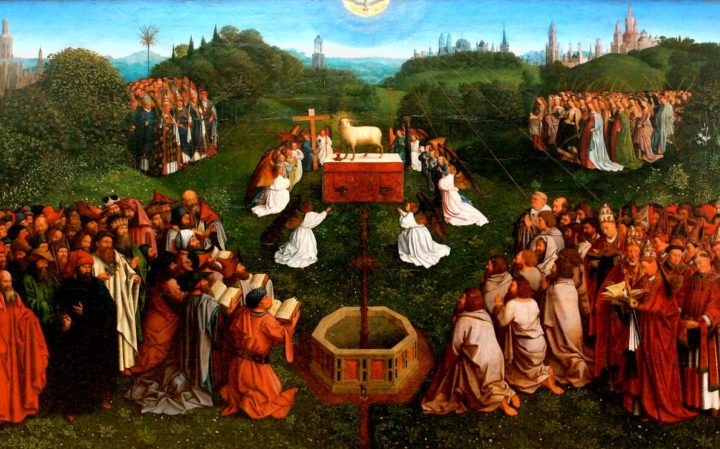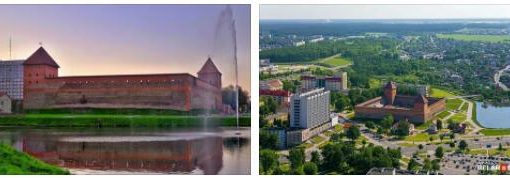Dutch art not only denotes art in the Netherlands, but also in present-day Belgium and part of the French border districts until 1581. About southern Dutch art after 1581, see art in Belgium.
The Middle Ages
Liege was the center of Carolingian time for bokmalerier of high quality, and in the 1100s for outstanding bronze and goldsmith plastic. Master Renerus and Godefridus of Huy were leading artists. Carved pillars, capitals, baptismal fonts, tombstones and so on were embellished with reliefs, sold and transported via canals and rivers to the country’s other provinces and abroad. In the 13th century, Gothic influence came from France.
The sculpture unfolded especially in the goldsmith’s art, for example at the Eleutherius shrine in Tournai and the Gertrud shrine in Nivelles. It also found space in connection with architecture and not least on tombstones with landscape figures, partly of stone and partly of bronze; these were also export goods. The French royal family Valois used in the second half of the 1300s Dutch sculptors and painters, especially book painters such as André Beauneveu, Jean de Liège (1330–1381), Claus Sluter and more.
The breakthrough of painting
France’s decline in the early 1400s led to material progress for the Dutch and thus for their art. In addition to tombs, the sculpture was used especially in golden and polychrome altars with carved, dramatic figure scenes. Especially from Antwerp and Brussels, such cabinets were exported in many ways, including to the Nordic countries.
The greatest role, however, played the painting, which had its breakthrough with the brothers Hubert and Jan van Eyck and their wing altar, the Worship of the Lamb from about 1420-1432, in St. Bavo’s Church in Ghent. There they showed their insight into the treatment of the oil colors and partly their mastery of space, light and atmosphere. Then followed Robert Campin and Rogier van der Weyden, who emphasized the plastic shape, drama and passion. Dirk Bouts, Hugo van der Goes, Albert Ouwater (1444–1475), Geertgen tot Sint Jans and Gérard David developed the mood as well in the landscape- as in the portrait painting. In a special position stands Hieronymus Bosch and the German-born Hans Memling.
Rome Hinduism
From the beginning of the 16th century, the influence of the Italian Renaissance language is felt. At the same time, impulses from the bedtime were still prevalent, as was evident in decorations in town houses. Then it was combined with fittings and cartilage for a lush, ornamental style that Cornelis Floris has the main honor of having created, among other things through his pattern books from 1548 off.
The painting also acquired the renaissance exterior equipment, composition, painting method, decorative details and the like. This direction is often called Romanism, and it belongs to Quinten Matsys, Jan Gossaert, Joos van Cleve and Bernaert van Orley, while Joachim Patenier especially cultivated the landscape and Lucas van Leyden genre painting.
In connection with Jan Scorel and Maerten van Heemskerck, Romanism developed further with Frans Floris, Maerten de Vos and Cornelis Cornelisz. In contrast to this school stands the domestic realism of Pieter Brueghel, Pieter Aertsen and Joachim Beuckelaer. Antonis’s mother was highly esteemed as a portrait painter, and Dirck Jacobsz, Cornelis Ketel (1548-1616) with several painted group portraits.
The independent Netherlands
The political upheavals led to a concentration on the national heritage and the resources of the homeland. This happened after the separation in 1581, and both in the north and in the south the Baroque appears to have been a wake-up call. It evokes the Flemish art with Peter Paul Rubens as the central figure in the 1600s.
Even richer were the results in the territory of the republic. The sculpture was mainly related to facade and interior decoration as well as to tombs. The classical academic direction did not disappear in the painting either, but the depictions and genre images became much more popular. Corresponding to the specific subjects, a strong specialization took place; painting was divided into a number of scenes, for example, marine art, landscape painting, architecture painting, genre painting, portraits, inns depicting hunting piece and Life.
With Gillis van Coninxloo, Hercules Seghers and Roelant Savery’s peculiar compositions, extensive landscape panoramas went to specific aspects of nature, such as those of Hendrik van Avercamp, Esaias van de Velde, Jan van Goyen and Salomon van Ruysdael. Pieter Saenredam painted church interiors, Pieter Codde company pieces and Frans Hals individual and group portraits with his liberated impressionistic technique.
Rembrandt expressed his rich humanity in an extensive circle of motifs spanning Old Testament representations, classical mythology, group portraiture and self-portraiture with a deep understanding of light and color.
On this basis, the best qualities of painting, from the mid-17th century to the end of the century, unfolded.
- Adriaen van Ostade, Carel Fabritius and Jan Steen specialized in genre images.
- Pieter de Hooch, Jan Vermeer van Delft, Gerard ter Borch, Gerard Dou, Emanuel de Witte, Frans van Mieris the elder, Caspar Netscher (1639–1684) and other painted people in the interior.
- Jacob van Ruysdael, Aert van der Neer and Philips Koninck painted landscapes.
- Willem van de Velde painted sea pictures.
- Meindert Hobbema painted woods and fields.
- Allart van Everdingen painted waterfalls.
- Aalbert Cuijp and Paulus Potter painted cattle.
- Philips Wouwerman painted horses.
- Pieter Claesz (1597–1661), Willem Heda, Jan de Heem and several painted still lifes.
Until the late 1800s, Dutch art was then almost a reflection of the changing fashions in France. After the settler Jozef Israël settled in The Hague in 1869, The Hague School, which was largely in line with the Barbizon School, took the lead in the painting with the support of the brothers Jacob, Matthijs and Willem Maris, Hendrik Mesdag (1831-1915) and more. Barthold Jongkind became a precursor to Impressionism, and Vincent van Gogh became the forefront of Expressionism. Jan Theodor Toorop became the center in an exotically oriented, symbolist ornamental direction and Johan Thorn Prikker (1868-1932) in a more abstract decorative direction, both around 1900.
1900s
In the years around World War I, Piet Mondrian and the De Stijl Group (1917–1928) emerged, and the Netherlands again became an important center for the development of the visual arts in Europe. Based on Cubism and with a strong connection to architecture and music, Mondrian reached a so-called pure painting: an almost ascetic, simple non-figurative art based on the horizontal, vertical and primary colors (neo-plasticism). This was of crucial importance for the further development of painting in Europe and the United States during the post-war and post-war years.
Just after World War II, the COBRA group (1948–1951) emerged, and the Netherlands played a major role in the development of expressive non-figurative art with Karel Appel as a central figure. The geometric-abstract visual arts seem to be well-rooted in the Netherlands and have had excellent representatives in the years from 1980 onwards. Otherwise, there are also interesting artists in all forms of expression today.





